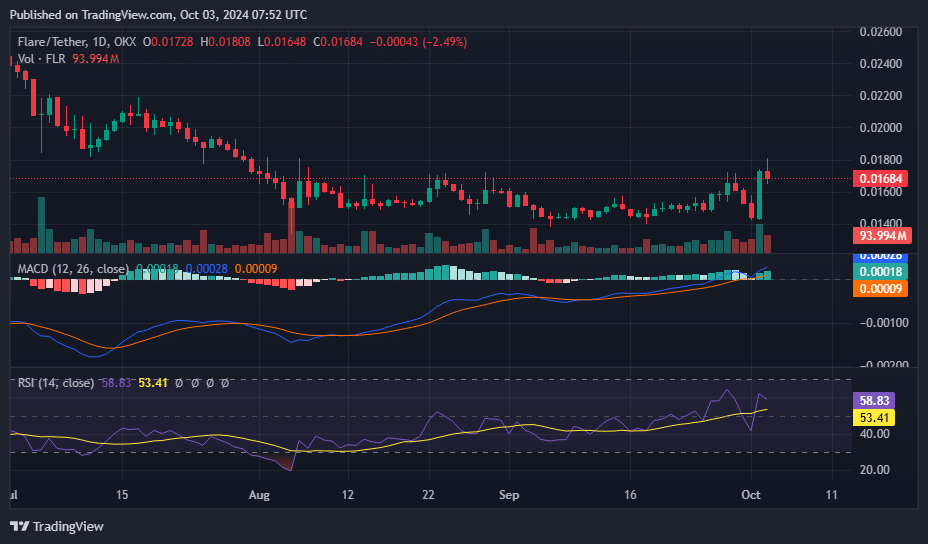cryptocurrency
FLR leads top altcoins in 24-hour gains despite market wide selloff
Published
3 months agoon
By
admin
FLR has emerged as the leading gainer among the top 100 cryptocurrencies, witnessing a 21% rise in price within the past 24 hours, driven by positive developments within its ecosystem.
Flare (FLR) climbed from a low of $0.0149 to a high of $0.0178, eventually stabilizing around the $0.016 range when writing. This significant uptick solidified a 12% gain for the day and propelled the market capitalization of its circulating supply of 48.487 million tokens to approximately $819.2 million while most of the crypto market struggled as Wall Street traded deep in the red.
FLR’s price upswing coincides with an explosive increase in trading volume, which has soared by over 390%, translating to more than $30 million worth of the token exchanging hands.
Strategic growth and technological integrations
The Flare Network has been actively broadening its technological and strategic footprint, which has contributed to its recent price performance.
Among key developments is the integration of Google Cloud earlier this year as an infrastructure provider—a partnership that significantly enhances the network’s data handling and validation capabilities, thereby elevating its standing in the blockchain ecosystem.
In an aggressive push to foster sustainable growth, Flare has committed to reinvesting 50% of its FLR token sales back into the ecosystem. This strategic reinvestment is earmarked for the enhancement of vital network functions, including lending protocols and decentralized exchanges, aiming to boost both the utility and intrinsic value of the FLR token.
Further, Flare has implemented a token burn policy, recently eliminating 66 million FLR tokens from the total supply. This adds to the bullish narrative, as reduced supply tends to increase scarcity and potentially drive up the token’s value.
Market sentiment
According to data from CoinMarketCap, the social sentiment around the token was largely bullish, with the majority of community members expecting the rally to continue.
Technical indicators, such as the Moving Average Convergence Divergence on the 1-day price chart, illustrate a bullish crossover—where the MACD line has crossed above the signal line, a pattern which typically means that the strength of the bullish trend is building.

However, the subdued histogram suggests that while momentum is building, it may not be strong enough for a major breakout yet.
The Relative Strength Index further corroborates this view, resting at 58.83—above the midpoint but below the overbought threshold, indicating a gentle but persistent uptrend.
Source link
You may like


Experts say these 3 altcoins will rally 3,000% soon, and XRP isn’t one of them


Robert Kiyosaki Hints At Economic Depression Ahead, What It Means For BTC?


BNB Steadies Above Support: Will Bullish Momentum Return?


Metaplanet makes largest Bitcoin bet, acquires nearly 620 BTC


Tron’s Justin Sun Offloads 50% ETH Holdings, Ethereum Price Crash Imminent?


Investors bet on this $0.0013 token destined to leave Cardano and Shiba Inu behind
Bitcoin
Metaplanet makes largest Bitcoin bet, acquires nearly 620 BTC
Published
4 hours agoon
December 23, 2024By
admin

Tokyo-listed Metaplanet has purchased another 9.5 billion yen ($60.6 million) worth of Bitcoin, pushing its holdings to 1,761.98 BTC.
Metaplanet, a publicly traded Japanese company, has acquired 619.7 Bitcoin as part of its crypto treasury strategy, paying an average of 15,330,073 yen per (BTC), with a total investment of 9.5 billion yen.
According to the company’s latest financial disclosure, Metaplanet’s total Bitcoin holdings now stand at 1,761.98 BTC, with an average purchase price of 11,846,002 yen (~$75,628) per Bitcoin. The company has spent 20.872 billion yen in total on Bitcoin acquisitions, the document reads.
The latest purchase is the largest so far for the Tokyo-headquartered company and comes just days after Metaplanet issued its 5th Series of Ordinary Bonds via private placement with EVO FUND, raising 5 billion yen (approximately $32 million).
The proceeds from this issuance, as disclosed earlier, were allocated specifically for purchasing Bitcoin. These bonds, set to mature in June 2025, carry no interest and allow for early redemption under specific conditions.
Metaplanet buys dip
The company also shared updates on its BTC Yield, a metric used to measure the growth of Bitcoin holdings relative to fully diluted shares. From Oct. 1 to Dec. 23, Metaplanet’s BTC Yield surged to 309.82%, up from 41.7% in the previous quarter.
Bitcoin itself has seen strong performance this year, climbing 120% and outperforming assets like the Nasdaq 100 and S&P 500 indices. However, it has recently pulled back from its all-time high of $108,427, trading at $97,000 after the Federal Reserve indicated only two interest rate cuts in 2025.
Despite the retreat, on-chain metrics indicate that Bitcoin is still undervalued based on its Market Value to Realized Value (MVRV-Z) score, which stands at 2.84 — below the threshold of 3.7 that historically signals an asset is overvalued.
Source link
Blockchain
Horizen spikes 60% to lead gainers as BTC, ETH bounce
Published
3 days agoon
December 20, 2024By
admin

Horizen price spiked more than 60% in 24 hours as the cryptocurrency market looked to recover from a massive dump that saw top altcoins crash to key support levels.
On Dec. 20, as Bitcoin (BTC) traded to above $97k and Ethereum (ETH) bulls pushed above $3,400, the price of Horizen (ZEN) surged to highs of $26.34. The cryptocurrency, which rallied sharply following a recent Grayscale Investments announcement, reached a multi-year high and ranked among the top gainers in the 500 largest cryptocurrencies by market cap.
ZEN traded at lows of $14.55 on Dec. 19. However, despite the broader crypto crash and the staggering $1.4 billion liquidations, the altcoin’s price hovered above $26 in early trading during the U.S. trading session.
According to crypto.news price data, Horizen recorded a 24-hour trading volume of over $397 million, with its market cap exceeding $407 million. These metrics reflected increases of 294% and 62%, respectively, in the past 24 hours. While ZEN has surged nearly 200% over the past month, its current levels are still more than 84% below the all-time high of $168 reached in May 2021.
If the broader crypto market continues to rebound, ZEN bulls may aim for March 2022 highs near $50.
The positive momentum has benefited from Grayscale opening of the Grayscale ZEN Trust to qualified investors. Prices of the altcoin rose as the digital asset manager unveiled the fund to offer exposure to Horizen for qualified investors.
Earlier this month, Horizen’s native token underwent its final halving, which came as the project geared for a key change in its tokenomics. ZEN will not see any further halvings as the new network mechanism enables a declining emission rate.
That’s because Horizen, is shifting from the proof of work mining model that mirrored Bitcoin’s halving cycle to a new proof of stake mechanism in 2025. Horizen’s last halving occurred on Dec. 12, 2024.
New tokenomics for Horizen will come into effect in the first half of 2025.
Source link
Binance
Binance Futures updates leverage and margin tiers for multiple USDⓈ-M perpetual contracts
Published
4 days agoon
December 19, 2024By
admin

Binance’s updated leverage and margin tiers offer improved trading options for select trading pairs, bringing both potential rewards and risks for crypto traders.
The leverage and margin levels for USDⓈ-M perpetual contracts, including DAR, ME, CAKE, IOTA, LPT, ONE, and ZEN, will be updated by Binance Futures today, with effect from 08:15 UTC on Dec. 19, 2024.
USDⓈ-M stands for USD-Margined Futures, a type of cryptocurrency futures contract offered on platforms like Binance. It refers to stablecoins such as USDT (Tether) or BUSD (BUSD), which are pegged to the US dollar. These contracts are settled in these stablecoins, rather than traditional fiat currency or the underlying crypto asset.
Depending on the contract and position size, the revised leverage tiers will vary from 1x to 75x, enabling traders to fully benefit from their leveraged positions in the crypto market.
Leveraged positions of traders will be impacted by the new maintenance margin rates, which range from 1.00% to 50.00%.
Margin is the total amount of collateral needed to open and sustain a trading position, whereas leverage is the borrowing of funds to increase the size of a position. The possible return increases with leverage, but the chance of loss also goes up.
By adjusting the margin and leverage tiers, Binance Futures continues to give traders more choices to control risk and profit from volatile crypto market movements.
Traders must keep themselves updated with Binance Future trading rules and exercise risk management, particularly when working with high-leverage instruments over several contracts and margin holdings.
Source link

Experts say these 3 altcoins will rally 3,000% soon, and XRP isn’t one of them

Robert Kiyosaki Hints At Economic Depression Ahead, What It Means For BTC?

BNB Steadies Above Support: Will Bullish Momentum Return?

Metaplanet makes largest Bitcoin bet, acquires nearly 620 BTC

Tron’s Justin Sun Offloads 50% ETH Holdings, Ethereum Price Crash Imminent?

Investors bet on this $0.0013 token destined to leave Cardano and Shiba Inu behind

End of Altcoin Season? Glassnode Co-Founders Warn Alts in Danger of Lagging Behind After Last Week’s Correction

Can Pi Network Price Triple Before 2024 Ends?

XRP’s $5, $10 goals are trending, but this altcoin with 7,400% potential takes the spotlight

CryptoQuant Hails Binance Reserve Amid High Leverage Trading

Trump Picks Bo Hines to Lead Presidential Crypto Council

The introduction of Hydra could see Cardano surpass Ethereum with 100,000 TPS

Top 4 Altcoins to Hold Before 2025 Alt Season

DeFi Protocol Usual’s Surge Catapults Hashnote’s Tokenized Treasury Over BlackRock’s BUIDL

DOGE & SHIB holders embrace Lightchain AI for its growth and unique sports-crypto vision
182267361726451435

Why Did Trump Change His Mind on Bitcoin?

Top Crypto News Headlines of The Week

New U.S. president must bring clarity to crypto regulation, analyst says

Will XRP Price Defend $0.5 Support If SEC Decides to Appeal?

Bitcoin Open-Source Development Takes The Stage In Nashville

Ethereum, Solana touch key levels as Bitcoin spikes

Bitcoin 20% Surge In 3 Weeks Teases Record-Breaking Potential

Ethereum Crash A Buying Opportunity? This Whale Thinks So

Shiba Inu Price Slips 4% as 3500% Burn Rate Surge Fails to Halt Correction

Washington financial watchdog warns of scam involving fake crypto ‘professors’

‘Hamster Kombat’ Airdrop Delayed as Pre-Market Trading for Telegram Game Expands

Citigroup Executive Steps Down To Explore Crypto
Mostbet Güvenilir Mi – Casino Bonus 2024

NoOnes Bitcoin Philosophy: Everyone Eats
Trending

 3 months ago
3 months ago182267361726451435

 Donald Trump5 months ago
Donald Trump5 months agoWhy Did Trump Change His Mind on Bitcoin?

 24/7 Cryptocurrency News4 months ago
24/7 Cryptocurrency News4 months agoTop Crypto News Headlines of The Week

 News4 months ago
News4 months agoNew U.S. president must bring clarity to crypto regulation, analyst says

 Price analysis4 months ago
Price analysis4 months agoWill XRP Price Defend $0.5 Support If SEC Decides to Appeal?

 Opinion5 months ago
Opinion5 months agoBitcoin Open-Source Development Takes The Stage In Nashville

 Bitcoin5 months ago
Bitcoin5 months agoEthereum, Solana touch key levels as Bitcoin spikes

 Bitcoin5 months ago
Bitcoin5 months agoBitcoin 20% Surge In 3 Weeks Teases Record-Breaking Potential


